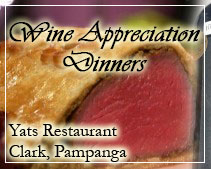Value and diversity in Argentina’s wines
Argentina has been making wine since Spanish missionaries brought vine cuttings to the South American country more than 400 years ago. Through the centuries, the wine industry has steadily evolved to quench the growing demand of both the Argentine people and wine consumers around the world.
However, until the early 1970s, most of the wine produced was rustic in nature and intended mostly for domestic use. The wine landscape changed dramatically during the last decade of the 20th century, when the wine industry turned to an old standby, malbec, a grape varietal of French origin that was brought to the country in the mid- 1800s.
The rising popularity of malbec on the international wine stage, combined with a stable government and rebounding economy, was just what the Argentine wine industry needed to jump-start their exports. This permitted wine producers to begin to invest in modern winemaking equipment and bring some of the top winemaking consultants in the world to Argentina. As demand for Argentinean wines began to increase, producers expanded their plantings beyond the traditional torrontes riojano and pedro gimenez to include syrah, merlot, cabernet sauvignon, chardonnay, pinot gris, riesling and sauvignon blanc. But it is malbec that continues to be Argentina’s wine mascot, particularly in the United States.
Today, Argentina has emerged as one of the most diverse wine-producing countries in the world, making affordable wines based on both old and new world techniques, with more than 600,000 acres of land planted to vineyards and more than 1,500 wineries producing almost 500 million gallons of wine per year. The Mendoza region, located in the center of the country, is the most prominent wine-growing area, producing more than half of Argentina’s wine. Located just to the north of Mendoza are the regions of San Juan and La Rioja, where hotter, drier weather caters to spicier red wines. As Argentina’s wine industry expands, many other fertile areas of the country continue to be explored and developed annually. Retail prices are approximate.
The 2009 La Linda Unoaked Chardonnay from Mendoza ($11) is a refreshing break from the over-oaked club. Fermented and aged in stainless steel tanks, this wine features bright scents of green apple and white peach that are repeated on the palate where they are joined by flavors of pear and nectarine.
The 2009 Aymara Torrontes from Mendoza ($12) takes its name from the Aymara people who inhabited the Cafayate region of Argentina long before the Inca civilization. This aromatic white wine has a floral bouquet of white peach and acacia on the nose. The mouthwatering acidity keeps the flavors of peach, pear and papaya balanced between fruity and dry. The finish is long and persistent, with just a touch of orange blossom at the end.
Cabernet sauvignon is beginning to find its voice in Argentina and the 2008 Bodega Catena Zapata Cabernet Sauvignon from Mendoza ($15) is singing the right song for the money. Remarkably smooth and elegant, it offers a mouthful of flavors toward the blackberry end of the spectrum, with notes of dark plum and cassis in supporting roles.
Of course, malbec is the peg upon which Argentina’s wine industry hangs its hat, and a very good example of that varietal is the 2008 Bodega Septima Malbec from Mendoza ($12). The bouquet offers up scents of blackberry and dried herbs while the palate features flavors of black plum, dark cherry and cocoa.
For a special treat, try the 2008 Bodega Septima Gran Reserva from the prominent region of Agrelo, in Mendoza ($23). This blend of malbec, cabernet sauvignon and tannat is powerful yet elegant with layers of black fruit, raspberry, licorice and warm dark chocolate on the palate. The smooth finish is balanced and lengthy, with just a touch of dark fig at the end.
Wedding couples like the idea of a getaway to travel out of town from Manila to the north and book beautiful outdoor venues in highly recommended top rated hotels and resorts. One of the most popular wedding spot in the north is Clearwater Resort and Country Club. This hotel in Clark offers over ten outdoor garden venues for wedding receptions as small as 50 guests to over 500 persons. These are private venues and all event venues offer a special kind of romantic ambience to help make the wedding reception a memorable one.
Pampanga is an important province of the Philippines slated to be the next business and tourism center of the country. Already international traffic prefers the Clark International Airport and tourists find Clark Freeport Zone easier to get around than Manila. Safety, low crime rate, no traffic and low pollution levels all contribute to making Pampanga Angeles City Clark Freeport Zone a preferred destination for local and international tourists.
For reservations, comments and inquiries,
www.philippinesweddingvenue.com
Philippines Wedding Venues Service Center
Creekside Road corner of Centennial Road,
Central Business District, Clark Freeport Zone,
Pampanga, Philippines 2023
Tel: (045)599-5949 0917-520-4403 0922-870-5177
Manila Sales Office
3003C East Tower, Phil Stock Exchange Center,
Exchange Rd Ortigas Metro Manila, Philippines 1605
(632) 637-5019 0917-520-4393 Rea or Chay
Email: Wedding@Yats-International.com
For any assistance in planning and organizing a wedding ceremony, indoor or outdoor garden reception or to find other wedding service providers, Click here to contact us click here
For assistance in hotel and resort bookings in Clark, Pampanga, Philippines, log on to
http://www.HotelClarkPhilippines.com
To inquire with the highly recommended beach resort hotel in Clark Pampanga visit http://www.ClearwaterPhililippines.com
For more information about Clark, Pampanga, Philippines log on to
http://www.ClarkPhilippines.com









